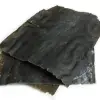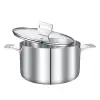BABISH
recipes
community
livestream
cookware
cookbook
contact
JOIN
ICHIRAKU RAMEN INSPIRED BY NARUTO

4,550,423 views If you've ever dreamt of slurping down a steaming bowl of ramen at Ichiraku, just like Naruto, this recipe is for you. This tonkatsu style ramen is heavily inspired by the recipe from Way of Ramen.
4 servings
US
original
metric
INGREDIENTS
DIRECTIONS
INGREDIENTS

For the Char Siu

900 g 1.4 kg pork belly (skin removed)

2 cloves of garlic, freshly minced

7.5 cm ginger root, freshly chopped

3 scallions, freshly cut into thirds

250 ml shoyu (soy sauce)

250 ml sake

250 ml water

200 g sugar

For the Miso Tare

275 g red miso

275 g white miso

275 g mugi miso (barley miso)

3 tbsp grated ginger

3 tbsp minced garlic

120 ml shoyu

120 ml sake

80 ml mirin

2 tsp togarashi (Japanese chili powder)

1 tbsp sesame seeds

For the Dashi

handful of niboshi (dried fish, heads removed)

2 pieces of kombu

1 dried shiitake mushroom

10 g katsubushi (dried bonito flakes)

For the Ajitama

6 large eggs

ice bath

For the Broth

pork femur bones, pre blanched

chicken carcass bones, pre blanched

chicken feet, pre blanched

pork fatback

½ head cabbage, chopped

1 large onion, roughly chopped

1 large carrot, roughly chopped

½ head garlic, sliced

3 scallions, chopped

1 ginger root, chopped

½ apple

1 potato, halved

ramen noodles, as desired

For the Toppings

2 scallions, chopped

narutomaki, sliced

Nori sheets

menma
TOOLS

Babish Chef's Knife

Cutting board

4 pieces of string or butcher's twine, equally cut

6 qt Babish Dutch Oven

otoshibuta or drop lid

Babish measuring cups

2.5 qt Babish sauce pan

Babish mixing bowls

3.5 medium containers or deli containers

Paper towels

Babish Stock Pot

Babish small pot

blow torch

thin needle or pin

strainers

emersion blender

slotted spoon

tongs

cooking chopsticks
DIRECTIONS
1.
For the Char Siu
1.
Prepare the pork belly: Trim excess fat and meat from the pork belly to create an even, rectangular shape. Save trimmings for another dish.

900 g 1.4 kg pork belly (skin removed)
2.
Roll the pork belly: Lay 4 pieces of butcher's twine on your cutting board. Roll the pork belly tightly into a cylindrical shape, placing it seam down on the twine. Tie the twine tightly to secure the shape. (Optional: slap the pork for quality assurance purposes)
3.
Prep the garlic, ginger root, and scallions.

2 cloves of garlic, freshly minced

7.5 cm ginger root, freshly chopped

3 scallions, freshly cut into thirds
4.
Sear the pork: Heat your Dutch oven over high heat. Sear the rolled pork belly on all sides until the edges are golden brown.
5.
Braise the pork: Add garlic, ginger, and scallions to the Dutch oven. Pour in shoyu, sake, water, and sugar. Bring to a simmer, place an otoshibuta, drop lid, or parchment paper lid on top, and braise for 2-3 hours until tender.

900 g 1.4 kg pork belly (skin removed)

2 cloves of garlic, freshly minced

7.5 cm ginger root, freshly chopped

3 scallions, freshly cut into thirds

250 ml shoyu (soy sauce)

250 ml sake

250 ml water

200 g sugar
6.
Chill and slice: Remove the pork from the braising liquid and allow it to cool.
7.
Skim as much fat as you can from the braised liquid with paper towels and strain. Set aside the liquid for marinating the eggs.
8.
Once the pork is chilled, slice into thin rounds.
9.
For the Miso Tare
1.
In a medium sauce pan, combine red, white, and mugi miso with ginger, garlic, shoyu, sake, mirin, togarashi, and sesame seeds.

275 g red miso

275 g white miso

275 g mugi miso (barley miso)

3 tbsp grated ginger

3 tbsp minced garlic

120 ml shoyu

120 ml sake

80 ml mirin

2 tsp togarashi (Japanese chili powder)

1 tbsp sesame seeds
2.
Heat over medium heat, stirring, until the mixture thickens slightly and the raw flavor of the ingredients has cooked off. Set aside for later.
3.
For the Ajitama
1.
Bring a pot of water to a rolling boil.
2.
Use a needle or pin to carefully poke a small hole in the bottom of each egg to prevent cracking.

6 large eggs
3.
Drop the eggs into the boiling water and swirl gently to center the yolks. Boil for exactly 6.5 minutes.
4.
Immediately transfer the eggs to an ice bath to cool.

ice bath
5.
Once cool, peel the eggs and place them in a small container with reserved braising liquid from the pork. Cover with a soaked paper towel to ensure even marination. Refrigerate for 24 hours.

For the Char Siu
6.
For the Dashi (soup base)
1.
Remove the heads from the niboshi.

handful of niboshi (dried fish, heads removed)
2.
In a medium container, combine headless niboshi and water to cover, about 2 liters. Set aside, allowing the fish to soak for 20-30 minutes.
3.
While the Tonkatsu broth is simmering, transfer the niboshi mixture into a small pot and introduce kombu and dried shiitake mushroom to the pot. Let soak for 10-15 minutes until hydrated.

2 pieces of kombu

1 dried shiitake mushroom
4.
On gentle heat, add the dried bonito flakes to the niboshi, kombu, and mushroom mixture. Let simmer until the heat is permeated.

10 g katsubushi (dried bonito flakes)
5.
Once the heat has permeated, strain the dashi into a measuring cup. Set aside.
6.
For the Tonkatsu Broth
1.
In a large stock pot, combine pre-blanched pork bones, chicken carcasses, chicken feet, and pork fatback. Add water to cover and bring to a boil.

pork femur bones, pre blanched

chicken carcass bones, pre blanched

chicken feet, pre blanched

pork fatback
2.
While the meat is in the pot, prep the vegetables for the broth. Chop the cabbage, onion, carrot, garlic, scallions, ginger root, apple, and potato.

½ head cabbage, chopped

1 large onion, roughly chopped

1 large carrot, roughly chopped

½ head garlic, sliced

3 scallions, chopped

1 ginger root, chopped

½ apple

1 potato, halved
3.
Once the meat starts to fall off the bone and becomes a little tender, introduce the vegetables to the pot and let simmer for 2-3 hours or until broth is rich and flavorful.
4.
When the ramen broth has thickened and reduced, taking on a milky color, use a whisk to break up remaining bones or vegetables for extra flavor. Fat should be emulsified within the liquid. If not, use an emulsifying blender to ensure the fat is fully incorporated.
5.
Introduce the dashi to the broth and stir to incorporate.

For the Dashi
6.
Strain the broth into a container.
7.
For the Toppings prep
1.
Slice the scallions and narutomaki.

2 scallions, chopped

narutomaki, sliced
2.
(optional) Brush the egg marinate on the sliced pork and use a blow torch to smoke and caramelize the pork slices.

For the Ajitama

For the Char Siu
3.
For the Assembly
1.
Cook the noodles: Squeeze and compress the noodles for springy form after cooking. Boil the ramen noodles according to package instructions. Drain and set aside.

ramen noodles, as desired
2.
Prepare the bowls: In each serving bowl, quickly add a few tablespoons of miso tare. Ladle the hot broth over the tare and stir to combine.

For the Miso Tare

For the Broth
3.
Add noodles to the bowl, top with sliced char siu, a halved marinated egg, sliced scallions, menma, narutomaki, and nori sheets.

ramen noodles, as desired

2 scallions, chopped

narutomaki, sliced

Nori sheets

menma

For the Char Siu
4.
Serve immediately.
Unlock this recipe

Welcome to the...
Babish Culinary Universe
Get instant access to hundreds of written recipes, connect with a community eager to share their cooking triumphs and mishaps, and find inspiration for your next meal.
Try it out for a month free, then just $1/month
RELATED RECIPES